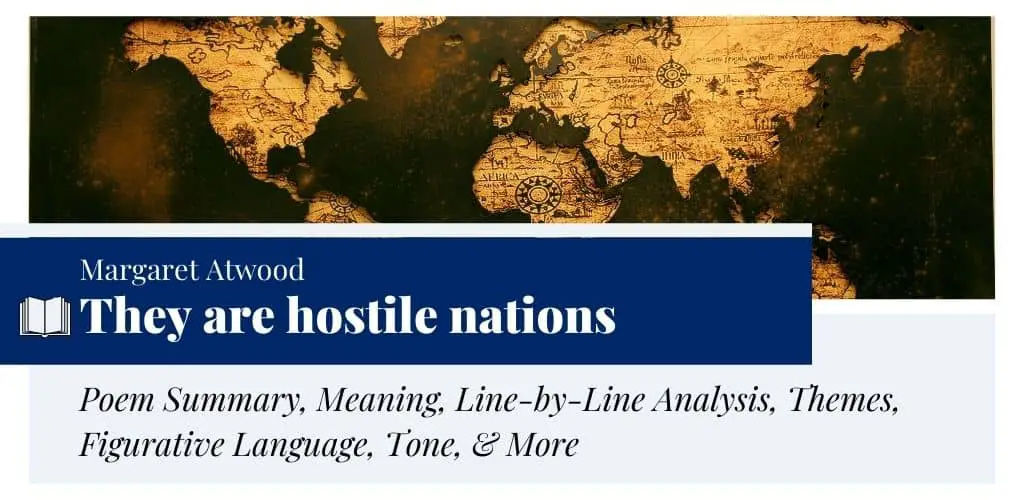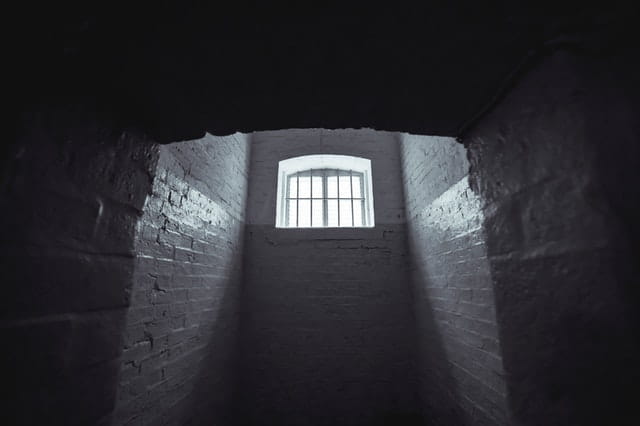They are hostile nations by Margaret Atwood
Margaret Atwood’s “They are hostile nations” was published as a part of her volume of poems, Power Politics, published in 1971. This poem, in particular, is about the Cold War between the USA and Russia, which started after World War II and lasted until 1991. Atwood describes the aftermath of war and the thought processes of the people involved. Atwood paints a descriptive picture of how everyone involved in war wants peace and cooperation but finds themselves helpless in a deteriorating environment.
- Read the full text of “They are hostile nations”

Summary
In the poem “They are hostile nations,” Atwood narrates the aftermath or impact of the Cold War on earth and, most importantly, humankind. She talks about how hostility among nations makes things worse for humans; people are dying, animals are fleeing, the air is polluted by the stench of dead bodies, smoke, and gunpowder. She emphasizes how the survivors that are left with little to nothing are craving warmth and affection more than anything else.
Meaning
“They are hostile nations” is a descriptive, first-hand experience of what war feels like – the unease that surrounds the people present. Their helplessness is conveyed through lines like “Put down the target of me/ you guard inside your binoculars,/ in turn, I will surrender.” The desperate wish for the war to just end is also expertly expressed by Atwood.
Inherently, the poem is very realistic – the poet dreams of an idealistic world where kindness and togetherness bind everyone together but immediately after this wishful thinking, she also expresses self-awareness by saying that we are the opposite of that.
The speaker paints a haunting image of the end of the war when the land is almost deserted, and only a few people from both “sides” are still alive. Atwood describes how it gets colder and colder during the end of the war, and even after the war, the survivors still crave human affection.
Structure & Form
Atwood’s “They are hostile nations” is written in free-verse, where the poet does not follow any traditional rules of poetry. The poem has no set metrical pattern or rhyme scheme. It is divided into three sections. The first section contains two quatrains at the beginning and end and two couplets in the middle. Section two begins and ends with tercets, with a quatrain between them. The last stanza contains a combination of a couplet, coda, quatrain, tercet, and a coda at the end. The punctuations and sentence patterns used in the text are quite unconventional. As for the point of view, Atwood employs the first-person narrative technique.
Figurative Language & Poetic Devices
Atwood uses figurative language in order to make her concern for the world and its people more appealing to readers. Readers can find the following devices in “They are hostile nations.”
- Apostrophe: Used in an instance where the poet talks to a person or object that is not present in the poem. For example, “you guard inside your binoculars,/ in turn I will surrender.”
- Enjambment: Where one sentence is continued in another line; for example, “Instead we are opposite, we/ touch as though attacking,” “See, we are alone in/ the dormant field, the snow/ that cannot be eaten or captured,” etc.
- Metaphor: When the poet describes one thing as another to explain an idea; for example, “See, we are alone in/ the dormant field, the snow/ that cannot be eaten or captured.” Here, the “dormant field” and “snow” are metaphors for the world and a food item/land, respectively.
- Alliteration: The use of similar sounds in neighboring words; for example, “warning, we,” “walking with me,” etc.
- Repetition: It is used for emphasis. Readers can find a repetition of “we” in “we should be kind, we should/ take warning, we should forgive each other.”
- Anaphora: It occurs in the following lines: “the proliferation of sewers and fears/ the sea clogging, the air” and “Here there are no armies/ here there is no money.”
Line-by-Line Analysis & Explanation
Section i
Lines 1-4
In view of the …
… extinction
Atwood begins “They are hostile nations” by describing how the animals either fled or died because of the war. The “proliferation of sewers and fears” – which shows that people were stifled with anxiety and terror as the war began. Furthermore, Atwood describes that the sea is clogging, which means that the blood, waste, or bodies of war victims are drowning at sea. In addition, the air is near extinction because of the stench of blood, gunpowder, or smoke.
Lines 5-8
we should be kind, …
… as though attacking,
This couplet is idealistic, filled with wishful thinking, where Atwood conveys how she wants the world to be. She prefers a world where people are kind to others. They show mercy to their enemies. Immediately after the idealistic thinking, she shows self-awareness and bases an opinion in reality. She shows how we are the opposite of that. Humans find even the slightest spark or “touch” to be a sign of future attack. Hence, they are always on their guards, prepared to latch onto their enemies with utter violence and hatred.
Lines 9-12
the gifts we …
… to manoeuvres
The poet ends the first section by reflecting upon the idea of kindness in a world like ours – how the gifts given with good intentions can become twisted, either by our preconceived notions or by treacherous men. The “gifts” (a metaphorical reference to the scientific and technological advancements) of humankind form the “warp” (foundation) of future war. They are used against the very essence of humanity in war manoeuvers or implements for mass destruction, such as nuclear weapons, missiles, bombs, etc.
Section ii
Lines 1-3
Put down the …
… I will surrender
The speaker starts this section by referring to the person that has targeted them. She is willing to negotiate peace and mutual understanding. All she wants is to surrender, given the condition that the person will not hunt her down. The helplessness in her tone reflects the suffering she endured in the past. She badly wants the worldwide violence to end. To establish peace in a war-ridden world, she wishes even to sacrifice herself.
Lines 4-7
this aerial …
… found so useful
In these lines, Atwood refers back to an aerial map that was used during the Cold War. The map marks the “weaker” or more vulnerable sections of an area to attempt an aerial strike. One’s vulnerable point is the strategic gain for the other. Each party marks those points in red for future reference. Who can tell that someday it would prove useful? This preparedness to direct an attack displays how hatred has sown its treacherous seeds within humankind.
Lines 8-10
See, we are …
… be eaten or captured
Atwood now describes how only a few people are left from both sides, so the rest of the land is deserted. It gets colder with no way to get rid of the snow. In the near future, the snow will inevitably overwhelm the survivors, who have no home or food left. Here, the “snow” symbolizes the leftovers of war. It also symbolizes the coldness of human hearts.
Section iii
Lines 1-2
Here there …
… is no money
In the third section, the speaker begins to describe how all the soldiers have been martyred. There is no money in sight, and the world seems eerily dystopian. In this section, Atwood projects a post-Cold-War world where economic depression is at its hike. No soldiers are left to wage war. To emphasize this dystopian picture, Atwood uses anaphora in these lines.
Lines 3-7
It is cold and getting …
… afford, stay
Atwood further emphasizes how the cold gets overwhelming, and the war survivors have no place to go. She explains how humans still need warmth and support despite all the despair and tragedy. Living in peace and surviving climate change is the only “war” they can afford now, given how everything else has been taken away from them.
Lines 8-11
walking with me, …
… (possibly) last summer
In the last lines of “They are hostile nations,” Atwood asks for someone to walk with her, even though they can only go as far as another few months with the bare minimum they have been left with. This shows the terrible aftermath of war and the deteriorating condition of nature. From the speaker’s voice, it can be inferred she is utterly cynical about a “better world.” She thinks they can possibly last until the summer.
Theme
Co-operation Instead of Hostility
Throughout “They are hostile nations,” Atwood persuades listeners to end the ongoing “war” against humanity and to be cooperative with one another. For instance, she proposes, “we should be kind, we should/ take warning, we should forgive each other.” This seems simple and idealistic but is completely the antithesis of the poem’s conclusion. Atwood addresses this by saying that we are the opposite of that. Even the slight thing as our touch is like an attack. The speaker talks to those they are getting targeted by and tries to express the desire for cooperation rather than violence.
In the last verse, when all seems to be done, Atwood highlights human warmth and affection and how even after all the tragedy, the survivors of war crave someone who will walk with them more than anything else. Atwood has done a fascinating job in conveying the many emotions that weigh heavy on the survivors of war.
Tone
The tone of the poem is dystopian, pessimistic, anxious, frustrated, and thoughtful. Atwood keeps the flow intact by using vivid imagery and makes the poem realistic and idealistic at the same time. The speaker is filled with cynicism, and she finds no sign of improvement in the world. She thinks everything has come to an end. The way humans have used the environment now is beyond repair. Besides, hostility among nations is a threat to humankind and the world they live in. That’s why the speaker, in a cynical yet compassionate tone, asks us to admit our mistakes till there is time. Otherwise, we are to be blamed for our own destruction, nothing else.
Historical Context
“They are hostile nations” was first published in Atwood’s collection of poetry, Power Politics, in 1971. Atwood, one of the best Canadian poets of all time, produced a total of six poetry collections in the 1970s. This poem is about the impact of the Cold War, which took place between the USA and USSR, and their respective allies – the Western Bloc and the Eastern Bloc. The war began after World War II. This war saw much economic, social and political propaganda, which hurt the civilians the most. Atwood masterfully describes the course and aftermath of the war in this poem.
Questions and Answers
Margaret Atwood’s poem “They are hostile nations” is about the aftermath of the Cold War. The speaker describes a world where people are suffering. Atwood writes this piece from a dystopian standpoint.
This poem was written in the 1970s. It was published in Atwood’s collection, Power Politics, in 1971. Throughout this decade, she published six collections of poetry.
The central idea of the poem is to illustrate how people crave cooperation instead of war, and even after the calamities, they need the warmth of human touch and support.
This poem is about the aftermath of the Cold War between the USA and Russia, which started just after World War II.
The poetic devices used in the poem are alliteration, repetition, metaphor, anaphora, etc.
This poem is written in free-verse, meaning there is no regular rhyme or meter. It consists of three sections, all of which are connected to the overall scheme of the poet. This piece is told from the perspective of a first-person speaker.
The speaker’s tone is cynical, anxious, frustrated, and dystopian throughout the piece. Her voice reflects the amount of emotional baggage she carries within her heart. All she craves is a world full of peace, compassion, and mutual understanding.
The speaker believes that humans should be kind towards one another. They should take warning and show mercy to their fellow beings. However, the cynicism within her heart makes her reject these ideas. Instead of highlighting these virtues, she utters her disgust by saying humans are just the “opposite.”
This poem taps on some important themes that include horrors of war, violence, destruction, climate change, cooperation, and peace. The poem depicts a dystopian world where there is no hope or sign of improvement.
In the opening verse of the second section, the speaker makes a deal of surrendering herself to the enemy. She asks her to remove her name from their target list. In return, she would surrender.
The speaker identifies violence and lack of compassion as the two enemies of humankind.
In this poem, the animals are fading (dying). The sea is clogging, and the air is nearing extinction.
Atwood wrote this piece with the singular purpose of showing humankind what they have done to the world. For piercing their blind intellect, she presents a dystopian picture of the world. There is snow everywhere and literally nothing to eat. Living in such a world is impossible.
Similar Poems about the Futility of War and Life
- “The animals in that country” by Margaret Atwood — This poem is about the history of the indigenous people of Canada. Explore more Margaret Atwood’s poems.
- “Dreamers” by Siegfried Sassoon — This sonnet presents how soldiers dream of the battlefield and what they actually face there.
- “Money Madness” by D. H. Lawrence — In this poem, Lawrence satirizes humans’ craze for money and material possessions.
- “A Brave and Startling Truth” by Maya Angelou — This poem is about universal cooperation, peace, and compassion.
External Resources
- The Poem Aloud — Listen to a beautiful reading of Atwood’s “They are hostile nations.”
- An Overview of “They are hostile nations” — Explore the “Dive in” section in order to ponder over the text.
- Biography of Margaret Atwood — Learn about the poet’s life and works.
- About Margaret Atwood — Explore the poet’s profile and read some of her best-known poems.
- Margaret Atwood, the Prophet of Dystopia — Learn more about Atwood’s dystopian view of societies riddled with misogyny, oppression, and environmental degradation.





